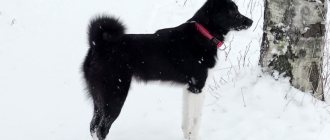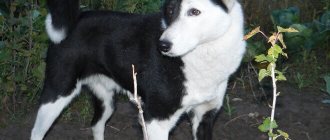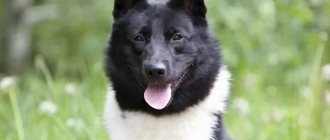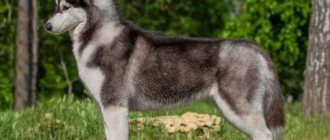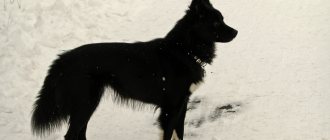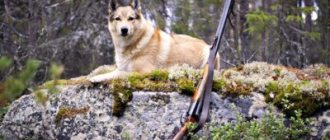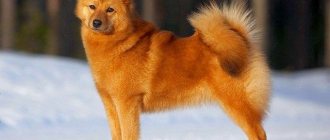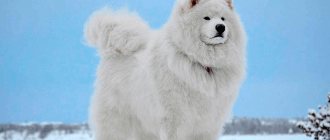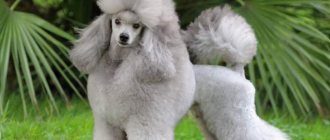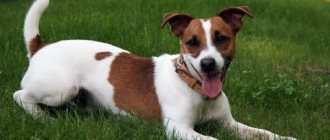Laika is a dog used for hunting. This is not the name of a separate breed, it is a term that unites several hunting breeds of dogs similar in appearance and origin. What all huskies have in common is that the breeds originated in northern countries, where these dogs were reliable human assistants in hunting, moving through snowy terrain and transporting goods.
Laikas are not only hunters, they are also faithful human companions. Dogs belonging to this species are bred as reliable helpers and friends. In this article we will tell you everything about huskies, introduce you to their varieties, talk about breed characteristics and features of the species.
History of the breed
Today, it is almost impossible to find reliable information about how this dog breed developed. Experts attribute this feature to the fact that in the northern conditions no one paid special attention to these dogs and did not specifically select them. Laikas lived next to people for many centuries, performing very important work, but at the same time they were not treated in any special way. Until recently, representatives of the breed were called “pointy-eared”, “northern” or “yard” dogs, but they became “likes” much later.
The oldest image of dogs was found on a fresco in a temple, whose construction dates back to the time of the existence of Ancient Kievan Rus, which means that the four-legged animals were somehow different from their own kind. Most likely this is due to the fact that in Western Europe hunting was a fun pastime, while in the northern regions and Siberia a person simply could not survive without such a trade.
The first breeding work with huskies was carried out by hunters: Poplavsky, Dmitrieva-Sulima and Shirinsky - Shikhmatov, and this happened in the last years of the 19th century. These people promoted the breed, classified huskies and built several large nurseries. From their trip to the northern lands they brought back the best representatives of pointy-eared dogs, which they purchased from the local population.
In 1925 of the 20th century, the first breed representatives were approved, which were brought to the First All-Union Exhibition, hence the popularity of huskies began. During the Great Patriotic War, northern dogs were used to walk in sleds, search for mines and perform other necessary functions. At the end of hostilities in our country, there were more than 60 nurseries of hunting dogs of various breeds, including huskies.
Breed standards were developed at the end of the 40s; they exist for a number of varieties of these four-legged animals.
Health
Characteristic diseases
The Samoyed dog is not susceptible to allergies and is quite resistant to a variety of diseases due to its unpretentiousness and high degree of endurance.
Among the diseases observed in Samoyeds, the most common are:
- bloating
- cataracts and retinal atrophy
- diabetes
- dysplasia of the joints, especially the hip
- problems with blood vessels and aortas
These diseases for the most part have nothing to do with the characteristics of the breed.
Characteristic congenital disorders may be deafness and depigmentation of the nose (lack of black color).
A healthy dog is always cheerful, cheerful and energetic. Any deviations should alert the owner
Vaccinations
differences from vaccinations for other dogs.
The animal is vaccinated at the age of two months, then again after about another month.
10 days before vaccination, the Samoyed receives deworming medications, and all vaccinations are recorded in the animal’s passport.
Description of the breed, character of the huskies
Today, there are quite a large number of sub-breed groups of huskies, we will talk about them a little later, but all dogs have common characteristics and external signs. The main feature is considered to be a love of hunting; the animals work well independently in conditions of freedom.
Devotion to the owner is combined with the love of freedom of these furry animals. They are distinguished by a soft and flexible character, but at the same time they will easily express their dissatisfaction if the owner treats the pet unfairly.
Dogs are very curious, which is also a typical trait of this breed. This feature should not be forgotten during walks, because a born hunter can easily run away a considerable distance, relying on his keen senses and catching up with his prey.
During a hunt, if the game is small (marten, squirrels), the dog crushes the victim and then carries it to the owner. Dogs detain larger animals and attract the owner's attention with loud barking.
The Laika will show aggressive behavior towards a person only when a dangerous situation arises. Representatives of this breed treat children very well. Keeping the situation under control, the hunter will react calmly to an outsider for the time being.
Northerners perceive the training process very positively, but they will not perform complex tricks to please a person. A potential owner should know that these dogs need to be trained and taught proper behavior from puppyhood.
Education and training
Remember once and for all: Samoyed huskies are self-sufficient and intelligent. They have a developed sense of self-esteem. Therefore, screaming and the use of physical force when raising and training a Samoyed are excluded. Samoyed husky puppies are raised from 2 months of age. Teach your dog to eat, do dirty tricks on the street and obey you. But from the age of six months you can start training at home.
An adult Samoyed should see you as a leader. And you need to work on this even in his puppyhood. Do not raise your voice, force the dog to give way to you if you are walking along the corridor and he is lying in the aisle, do not allow him to sleep in your place and, especially, do not feed him from your hands. In case of disobedience, grab the puppy by the withers (as a she-wolf does) and lightly press him to the ground.
Breed standard
Each type of husky has its own breed standards. Here we will talk about what parameters the West Siberian variety should have. You can get acquainted with them in the table.
Breed standard and deviations
| Standard name | Norm (for males and females) | Vice |
| Dimensions | Males height at withers 55 – 62 cm Bitches height at withers 51-58 cm | Any deviation up or down |
| Suit | White, zone, gray, red, brown (any shade). White coat color allows for a brown nose | Black, black with white (not zonal), the appearance of specks on the body, head, paws does not match the main color.* |
| Wool | The guard hairs are straight and hard, there is an undercoat that is well developed and is soft and fluffy. | The presence of wavy and curly hair, excessive length, the presence of camber on the back, as well as dewlap on the tail.** |
| Skin, muscles, bones | The skin is dense, elastic, the muscles are well developed, the bones are strong | Any deviation from the norm |
| Head | It is wedge-shaped, the skull is moderately wide, the forehead meets the muzzle without sharpness, the muzzle should be sharp, long, but not narrow. Lips fit tightly, there are no drooping or jowls | The presence of a head of a raw and heavy type, there is a sharp steep transition from the frontal lobe to the muzzle, the muzzle itself is short and upturned |
| Ears | They have a high stance and the shape of elongated triangles, stand straight, the lobe is weakly defined | The presence of a round top, prominent earlobe*** |
| Eyes | Small in size, almond-shaped, dark brown or hazel in color, eyelids have a sharply oblique cut | Round eye shape, straight eyelids, color other than brown (white, yellow, green, etc.) heterochromia |
| Teeth, bite | White in color, large in size, should fit tightly to each other. Scissor bite | Deviation from the general provisions of the breed standard |
| Hind limbs | Good muscularity, good definition of angular articulations when viewed from the side | Pronounced straight rear, excessive closeness or spread of the hocks |
| Forelegs | Moderately oblique shoulder position, good muscularity, | Pronounced size, presence of clubfoot, straight shoulders |
| Tail | Bend into a steep ring on the back or side. It can be sickle-shaped, but it must touch the back. Straight reaches the hock joints or be 1-2 cm smaller, but not shorter | Tail shaped like a rod, plume or saber |
*huskies with brown and brindle colors are considered out of breed;
** Short-haired and long-haired dogs are considered out-of-breed;
*** the presence of drooping, semi-erect ears with drooping tops makes the dog out of breed.
Color and coat
The Russian-European Laika is found predominantly in black and white. It can be black and piebald or plain white or black. But even a pet of the same tone, for example, snow-white, must have at least one black spot. Conversely, a white spot is necessarily present in a completely black animal. Markings on the ears and legs are considered undesirable for this breed. The gray color of the pet and thick ripples on the head and legs to match the color mean that the animal has shortcomings in the breed. But dogs with a red tint of fur or specks on the body, head and legs that do not match the overall color are considered a serious defect in the offspring. Pets with brindle and brown colors are rejected and placed outside the breed.
Straight and coarse hair, lush and well-developed undercoat - this is a description of the normal characteristics of the coat of the Russian-European Laika breed. Photos of pets show that the hair on the head is shorter, and a woolen muff (collar) is formed on the neck and shoulders. This is a feature of this breed, and the absence of a muff is considered a fault, except when the animal is shedding. The fur on the paws is shorter and stiffer, and the tail is luxuriantly covered with straight hair. On its underside the hairline is longer. Short or long hair, curly or wavy hair, underdeveloped undercoat - this is a list of defects that discard a pet and put it out of breed.
Types of huskies
Now it’s worth talking about the types of huskies that exist.
West Siberian
The height at the withers should be 55–62 cm for males and 51–58 cm for females.
Representatives of this group have average or above average height. They are distinguished by a strong and strong physique. According to the standard, the length of the body from the shoulder-scapula joint to the ischial tuberosities should not be much greater than the height at the withers.
West Siberian huskies have pronounced sexual dimorphism, males are larger than females and look more masculine. Both have well-developed muscles and strong skeletal bones.
Among the suits allowed according to the standard are the following:
- gray-zonal;
- red-zoned;
- gray;
- redhead;
- fawn;
- red-brown of any shade.
It is acceptable to have a white suit or piebald. On the white coat there are spots of any color than those listed in the list.
Russian-European Laikas
According to the standard, the height of males at the withers is 52 - 58 cm, females 48 - 54 cm. The dogs are medium in size, strong in build and have a square body. The length of the body can exceed the height at the withers. Representatives of the breed have strong bones and well-developed dry muscles. Just like the previous species, sexual dimorphism is developed.
Among the acceptable suits typical for the group:
- black with white;
- white with black;
- pure black;
- pure white.
East Siberian Laika
The height at the withers is 57–64 cm for males and 53–60 cm for females.
Representatives of the group are of medium size and have a compact but strong build. The head size is quite large. Males have stronger bones than females. Females, like males, have well-developed muscles.
Acceptable suits include:
- black with tan markings of red color;
- black;
- black with white;
- gray;
- redhead;
- brown;
- zonal;
- fawn;
- white;
- spotted with all the colors listed above.
According to the standard, the paws may have a small number of specks of the same color as the main color.
Representatives of the species are distinguished by a remarkable indicative reaction and an excellent sense of smell. Such a dog shows excellent hunting qualities, especially for large animals. The dog works best on its own. Laikas have a good disposition and are trusting of people.
Bear Karelian Laika
The standard established for males the height at the withers is 57 cm, for females 52 cm, a variation of 3 cm is allowed both in greater and lesser directions. In weight, males can reach 25–28 kg, females 17–20 kg. The dogs are medium in size and have a strong and robust build. The coat is thick.
Moose Norwegian Husky
According to the standard, a male must have a height at the withers of 52 cm, and a female 49 cm. The appearance is typical for all huskies. The body is compact and short, the cervical region is flexible and has the correct position. The coat is thick and abundant, but not harsh or too long. The tail is wrapped in a tight ring lying on the back.
Finnish Spitz (Finnish Laika)
The breed standard established the height at the withers for males is 47 cm, for females 42 cm. A deviation of 3 cm upwards and downwards is acceptable.
The height is below average, the body is square-shaped, while it is strong and dry. This variety is suitable for hunting birds of the grouse family, small predatory animals, waterfowl and elk.
Hunting with Russian-European Laika
Russian-European huskies are universal hunters, in Russian realities they work excellently on both game and any animal. In addition to its sense of smell, the breed uses sight and hearing in its search, which makes hunting with reels as productive as possible. In addition, Russian-European Laikas are distinguished by the breadth and speed of their search, which helps them successfully compete with Westerners. A very important nuance: different techniques for working with game and animals, found in representatives of different breed lines. Typically, most relics work with their lower senses, following the scent directly, and only occasionally using their auditory receptors.
Some huskies belong to the high-sniffing type, that is, they are guided by the smell coming from the ground and distributed by the lower layers of air. Moreover, under different conditions, the dog can change its reconnaissance technique, moving from the upper to the lower scent and back. A separate category of REL are those who hunt by hearing. The sensitivity of such individuals is slightly less developed, therefore, in the process of pursuing prey, the animal often stops, then runs towards the sound and only barks at the prey in the end. In all respects, spirit huskies are considered ideal hunters, having equally developed sense of smell and hearing, but there are much fewer such individuals, and they are difficult to find.
Some experts recommend specially training your pet's hearing, starting from puppyhood. The Laika is taught to listen to the whisper of its owner, to pay attention to the sounds of living nature - the cries of birds, the knocking of a woodpecker on a tree. However, such exercises do not always give the desired result, since individuals with a dominant sense of smell will still prefer to rely on their nose rather than their own ears.
Pros and cons of the breed
Like all other dogs, huskies have their positive and negative sides, which you can get acquainted with in the following table.
Advantages and disadvantages
| pros | Minuses |
| Balanced psyche | Time for coat change. During this period, dogs acquire a not very attractive appearance. Tufts of thick fur will be scattered throughout the house. Pets need to be brushed at least once a week. Frequent washing of huskies is not recommended. Dogs have a thick undercoat that is very difficult to get wet and equally difficult to dry. Against this background, skin irritations may develop in huskies. Dry shampoos or foams are used for wool |
| No aggressive behavior towards people | High risk of infection. While hunting, huskies spend a lot of time in the lap of nature (forests, meadows, etc.) This is where dogs are exposed to insect bites and can pick up ticks or fleas with all the ensuing consequences. It is necessary to strictly adhere to the schedule of vaccinations and deworming |
| Active energetic behavior | Dogs often suffer from plaque and tartar, which leads to various oral diseases |
| Amenability | Manifestation of waywardness |
| Smartness | Apartment keeping is not recommended due to the overly active nature of the dogs. |
| Excellent performance even in harsh conditions. The dog can participate in hunting for several days and will not need complementary feeding. | The need for long daily walks |
| Unpretentiousness in the diet. It is enough to give simple food from porridge, fish products, vegetables and do without delicacies | |
| Quick adaptation to living conditions | |
| Ability to learn | |
| Friendly character allowing huskies to get along with both children and other members of the animal family | |
| The ability to navigate in space, excellent hunting qualities combined with excellent vision, hearing and smell | |
| Infinitely loyal to their owner |
Maintenance, care
The thick fur of huskies allows the animals to feel great in low temperatures. It will not be difficult for them to settle down to sleep right in a snowdrift. But in hot climates, representatives of this breed are extremely uncomfortable. It is recommended that such a dog be kept outdoors rather than indoors.
Laikas are very active animals, and therefore they need to be walked for a long time every day and at the same time given physical activity.
When walking, it is best to choose an open space located as far as possible from the highway. If there are no such places, then the pet needs to be walked without letting it off the leash.
Representatives of this breed are distinguished by cleanliness, but frequent washing is contraindicated for them due to the thickness of the undercoat, which dries very poorly. To take care of the coat, the owner needs to comb his pet several times a week and use dry shampoos.
Feeding
After a husky puppy appears in the house, the owner’s first need is to provide the animal with daily nutrition. Here you can use both specialized (store-bought feed) and natural products. It is strictly forbidden to mix both of these options.
The growth and development of a dog depends on the diversity of its diet, especially in the early stages of life, when skeletal bones, muscles, etc. are being formed.
Worth knowing! Until six months of age, the puppy should eat 5 to 6 times; after the 6th month, reduce the number of meals to 3 to 4 times a day.
Adult animals should receive food twice a day, in the morning and evening. It is important to remember that the dog should always have a bowl of clean drinking water available to him.
The natural diet is represented by boiled or steamed food. The permitted products include the following:
- beef;
- pork;
- rabbit meat;
- bird;
- fish;
- milk products;
- occasionally raw eggs;
- vegetable crops.
There are some types of food that you should absolutely not give to huskies. This includes not only smoked, fried, salted and spicy foods, but also the following:
- pea grain;
- potato;
- wheat bread;
- sweets in any form;
- pasta.
A dog’s health and life expectancy depend on a high-quality diet. If you follow all feeding standards and properly care for your husky, it will live for about 10–15 years.
Upbringing
Before you bring the puppy home, you need to choose a place where he will sleep and eat, they must be strictly defined. A potential owner should remember that the puppy will go to the toilet after feeding and after waking up. To avoid further problems, the puppy must be taken outside on time, where he will relieve his natural needs. The main thing in this matter is perseverance and perseverance, only then the pet will begin to understand what it must do. By the age of two months, a husky puppy should have a clear idea of where its place is, where feeding occurs, obey the command “come to me” and have the correct reaction to the sound of a whistle, which will replace the voice command during the hunt.
Continuation of the reinforcement of this command and the call signs of the whistle must be reinforced after the puppy turns three months old during full walks. At this point, it is necessary to begin training the main commands. By 4 months of age, properly trained young dogs are mostly effortless and can do all of the above.
To stimulate obedience, it is important not to forget to praise the dog and give it its favorite treat, which the husky will appreciate.
When raising a puppy, the owner must show persistence and firmness, but there should not be excessive cruelty. You need to know all the inclinations and characteristics of your pet in order to use them to develop the necessary skills in the animal. If there are harmful tendencies, then they must be nipped in the bud, otherwise they will later become habits that will be very difficult to get rid of. The laying of the foundations of education for this breed continues until the age of one.
What to feed the Samoyed?
The Samoyed's menu should include nutritious foods: porridge, boiled meat and fish, dairy products and vegetables. But before developing a diet, check with the breeder what he fed the puppy. If the dog is accustomed to ready-made food, it is worth switching it to natural food gradually. If you also choose food, give preference to top quality products made specifically for this breed. When eating natural foods, you should exclude from the menu:
- raw meat;
- eggs;
- chicken and pork bones;
- chocolate.
Feed the animal after a walk. As soon as your pet finishes his meal, remove the food bowl. This disciplines him and saves him from overeating and, as a result, obesity.
Puppies
Most often, this breed is purchased for hunting, and there are a number of features that can help you choose a good working dog.
Choosing a puppy
You cannot do without an external examination of your future pet; a healthy puppy must meet the following requirements:
- active behavior – attempts at long runs, quick ability to find yourself in a sitting position;
- eyes and ears should be clean, the same applies to the skin on the abdomen. The presence of an umbilical hernia is already a bad sign;
- lack of aggressive behavior is unacceptable for a hunting dog;
- calm and independent character.
It is worth paying attention to gender. Males are larger in size and have some aggression in their character, and therefore such a dog will have to be dealt with more seriously. This husky is suitable for hunting large animals (boars, moose, bears). Among the disadvantages are the clarifications that arise between dogs during a hunt.
Bitches are somewhat smaller in size, but they are considered more resilient compared to representatives of the opposite sex. They are easier to train, and their character is more flexible. They are distinguished by universal use in hunting from small animals to large ones. Relative disadvantages include sexual hunting, whelping and caring for offspring.
Description and features
Samoyeds not only look beautiful and attractive, but you cannot be deceived by their appearance. After all, Samoyeds are actually the friendliest and most peaceful dogs. This is largely why they have become so popular all over the world: the breed from the harsh north turned out to be not harsh at all, but loving people, flexible and understanding.
Samoyeds thrive in large families. They love children, love attention, but are not too demanding of it. The Samoyed Laika breed is always ready to chat with people, not only with its owners, but also with friendly strangers. Samoyeds even treat other animals well, including cats.
If a Samoyed is deprived of attention, it may become upset or even depressed. The pack instinct is highly developed among Samoyeds: the dogs were always close to people and each other, warming themselves in the cold weather.
In addition, Samoyed dogs are very smart. They easily learn commands, perform tricks with interest and easily remember the rules of the house. The breed is not endowed with stubbornness and self-will, so the Samoyed will not try to dominate its owner. Even a child can cope with a Samoyed.
Samoyeds love to play, but they are not as active as huskies. Although they have a hunter's instinct, they will not rush to chase a squirrel in the park or a cat on the road - they are much more interested in carrying objects for their owner and going through obstacle courses. If something makes the Samoyed angry or irritated, he does not bark, but simply leaves, avoiding unpleasant interactions.
Price
Before buying a dog, a potential owner must understand why he needs a husky in the first place. If you need a working or guard dog, you can purchase a puppy without documentation, but it must have working parents. Here, representatives of the breed may have some flaws in appearance, but they will have the required skills. Pets with documents will be needed for breeding and exhibitions.
- Russian-European huskies from working parents in the absence of a pedigree will cost in the range of 2,000 – 10,000 rubles. When preparing documents, the price increases to 10,000 - 40,000 rubles.
- East Siberian puppies 4000 - 5000 in the absence of documents, in them 10000 - 20000.
- The remaining varieties cost 3,000 – 5,000 rubles without pedigrees; its registration increases the cost at least twice.
Who determines and how to determine the breed of a Laika dog puppy
The guarantee of a puppy’s purebredness is its pedigree. Before purchasing, you should definitely ask what kind of mating the puppy was born from. Was this a planned mating within the club or was it the offspring of a random one? The purity of the blood is confirmed by a document issued for the dog’s offspring. Without a document, certain difficulties will arise to determine the breed of the dog - whether it is a husky or not.
What do husky puppies look like?
If upon purchase it turns out that the relevant documents are missing, you can try to determine the purity of the blood in the following ways:
- Contact professionals who know everything about the Laika breed.
- Ask the breeders to show the mother of the babies.
- Review the parents' documents.
- Check for the absence of disqualifying defects.
- Evaluate the exterior, compare with the Standard.
Husky puppies look like this:
- husky puppies look like little wolf cubs;
- the tail curls into a ring;
- the fur resembles plush;
- A husky puppy's ears stand up as they grow older.
Important: if you want a husky puppy for a show career, with good performance characteristics, do not buy animals from your own without documents.
Owner reviews
Most owners praise their pets very much, but do not forget to mention that the dogs are very energetic and therefore need long walks. Some people talk about the willful nature of huskies, which is not so easy to deal with. Still others say that a number of problems are caused by caring for a pet during shedding.
As a conclusion, I would like to remind potential owners that huskies are dogs that need to be constantly exercised. These are working dogs, not fluffy pet toys; if you do not load your pet with the loads it needs, then it will find entertainment for itself, which the owner may not like at all.
Character and intelligence
The character of the Russian-European Laika requires a powerful and emotionally strong owner next to it. The dog is very persistent and quite vicious towards wild animals. When it sees prey, it can bark at the animal for a long time and approaches carefully. With proper upbringing, she extremely rarely shows aggression towards people. This dog has a very well expressed territorial instinct.
Therefore, a husky can only follow a dog with which a certain connection has been established. The husky also strongly protects its territory and does not allow strangers into it. She is very smart, but to fully demonstrate her abilities, she needs to go out hunting, assess the situation and make the logically correct decision. In urban environments, she can run away and get lost.
Dog behavior
A dog may start barking loudly when its owners are away. By barking, the dog informs its owner about approaching danger or the discovery of prey. This can become a problem if you do not live in a private home. Laika is quite balanced in behavior, but when other animals appear, it can begin to behave aggressively, showing its territory and its superiority.
Attitude towards children and others
Laika does not like small children because she demands respect, and at an early age a person does not always understand what can be done and what cannot be done. She treats older children better, loves to play and spend time with him.
Laika becomes strongly attached to its owner if he pays her due attention and is actively involved in her upbringing. The dog chooses only one owner; it loves and respects the rest of the family, but does not treat it as devotedly as it does to its main owner.
If properly raised, a Laika will never swear at others who do not violate the space of its owner. Since huskies strongly defend their territory, the entry of strangers and animals into it can cause spontaneous aggression. But the owner’s word will correct this situation.
Training and education
The Russian-European Laika is quite difficult to train due to its love of freedom and constant desire to run away somewhere. Only hunting allows a dog to fully realize its potential and demonstrate its mental abilities.
As soon as a husky appears in the house, from the first days it must be taught to behave correctly and follow commands. The dog must be shown who is boss in the house.
Important! You should not physically punish your dog, since it should feel protected in its home.
It is also necessary to pay special attention to the dog’s socialization and communication with other animals, since going out hunting can scare the dog away. If it develops on its own, then it will soon cause its owner a lot of inconvenience, from barking for no reason to complete disobedience.
For the full development of instincts, it is necessary to regularly spend time with the dog in nature. To train a dog to hunt, you must either entrust this to an experienced person, or consult with him and work with the animal yourself.
